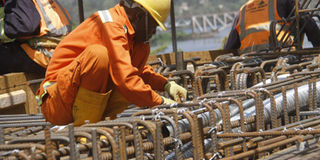How to stay healthy during construction

Wear protective gear at all times and if it is not provided by the employer, demand for it. Photo by Abubaker Lubowa
A construction site is always one accident waiting to happen. Apart from the numerous accidents bound to occur, construction workers face health risks and psychosocial problems. Various studies show that more construction workers are killed, injured or suffer ill-health than in any other industry. Even more alarming, a recent survey in Australia revealed that each year more than 40 workers die due to suicide and more than 100 suffer permanent disability as a result of unsuccessful suicide attempts.
Hasifa Nakazzi, a construction site manager, seems relaxed about those alarming statistics since she has not experienced any health or psychiatric issues on the numerous sites she has managed over a career that spans several years.
“I do know that accidents happen but not on any sites that I have managed. I think that it all depends on the responsibility and professional level of the workers,” Nakazzi elaborates. She reveals that her workers are always careful and have appropriate personal protection equipment.
Doctor George Bwesigye, a general physician at Najjera Hospital, suggests that some health damage might not be visible now but will show in the long run. “…Or they might not complain to her about their aches and pains for fear of losing their jobs or being labelled weak,” he explains. According to Dr Bwesigye, the biggest health damage faced by construction workers is damage to their backs and muscle damage.
Respiratory problems
He also points out that consistent exposure to noise from construction equipment over long periods is likely to lead to permanent deafness. The fumes caused by welding are known to cause damage to the respiratory system resulting in illnesses such as asthma and in severe cases pneumonia. He suggests earplugs and protective eyewear to avoid these defects.
A construction site is a pot bed of all types of hazardous chemicals. Cement can cause ill health by skin contact, eye contact, or inhalation. Risk of injury depends on duration and level of exposure and individual sensitivity. Wet concrete and mortar contain hazardous materials such as alkaline compounds such as lime (calcium oxide) that is corrosive to human tissue, crystalline silica which is abrasive to the skin and can damage lungs and chromium that can cause allergic reactions.
According to The Electronic Library of Construction Occupational Safety and Health (eLCOSH.org), inhaling high levels of dust may occur when workers empty bags of cement. In the short term, such exposure irritates the nose and throat and causes choking and difficulty breathing. Sanding, grinding, or cutting concrete can also release large amounts of dust containing high levels of crystalline silica.
Prolonged or repeated exposure can lead to a disabling and often fatal lung disease called silicosis. Some studies also indicate a link between crystalline silica exposure and lung cancer.
Minimising exposure
• When laying concrete blocks, have different sizes on hand to avoid cutting or hammering to make them fit.
• Work in ways that minimise the amount of cement dust released.
• Where possible, wet-cut rather than dry-cut masonry products.
• Mix dry cement in well-ventilated areas.
• Make sure to work upwind from dust sources.
• Where possible, use ready-mixed concrete instead of mixing on site.
• When kneeling on fresh concrete, use a dry board or waterproof kneepads to protect knees from water that can soak through fabric.
• Remove jewelry such as rings and watches because wet cement can collect under them.
• Every construction site has a scheduled period it must be completed. for contractors, finishing on time means saving money as such they drive expect their workers to comply with this schedule which results in a lot of pressure and consequently stress.
In addition to the pressure, construction workers especially in Uganda have little protection meaning that they are at their manager’s mercy to hire and fire on whim. “That kind of environment wreaks havoc on the individual’s psych resulting in low self-esteem, fear, distress and depression,” Dr Bwesigye adds.
Responsibility
Fred Ocen, a construction lawyer with Milton and Company Advocates, explains that ensuring safety on the site is everybody’s responsibility.
“It is important that both the contractors and workers ensure their own safety although the contractor has a bigger responsibility,” Ocen clarifies.
He adds that according to section 13 of Occupational Safety and Health Act, 2006, the employer is more obliged to ensure health, safety and welfare of persons at workplace. The act states thus: “Employer must take measures to keep the workplace pollution-free by employing technical measures, applied to new plant or processes in design or installation, or added to existing plant or process; or by employing supplementary organisational measures. Employers must ensure safe working environment including its vicinity. Proper arrangements should be made to ensure safety and absence of health risks related to the use, handling, storage and transport of articles and substances. Provision and maintenance of workplace which is adequate regarding facilities and arrangements for the welfare of worker is also important.”




